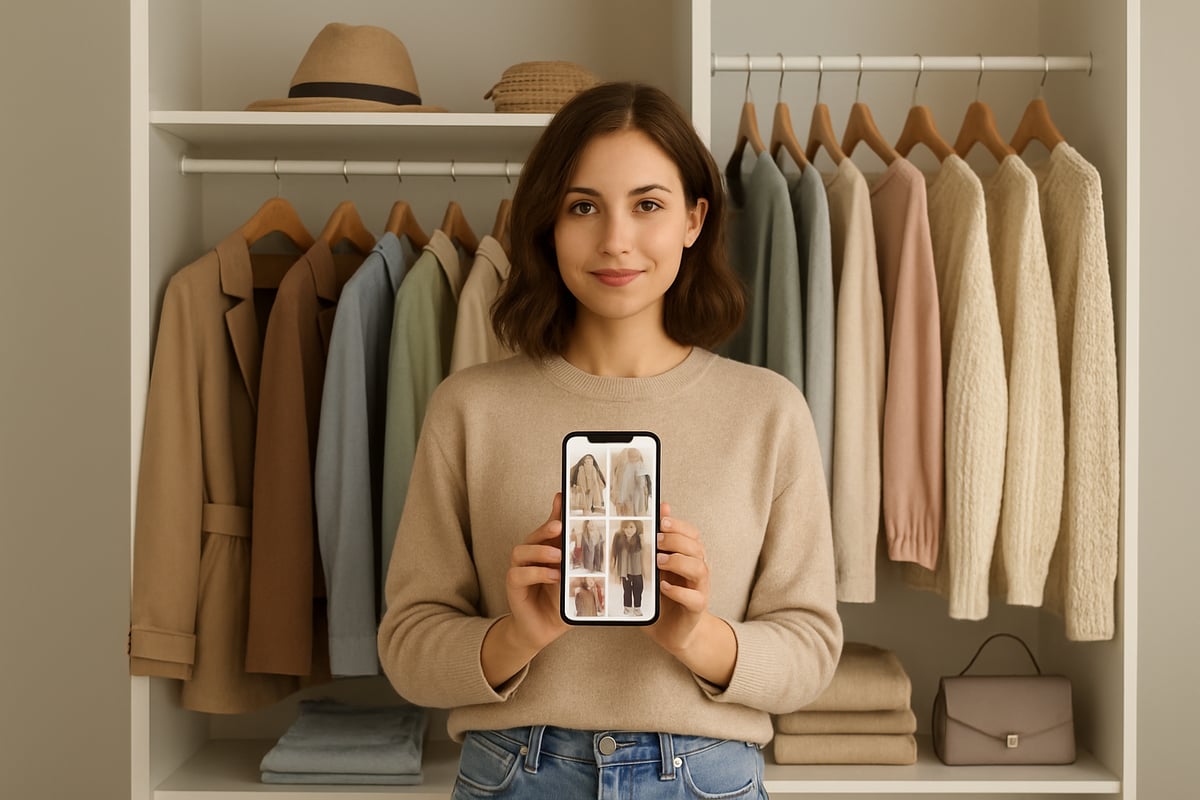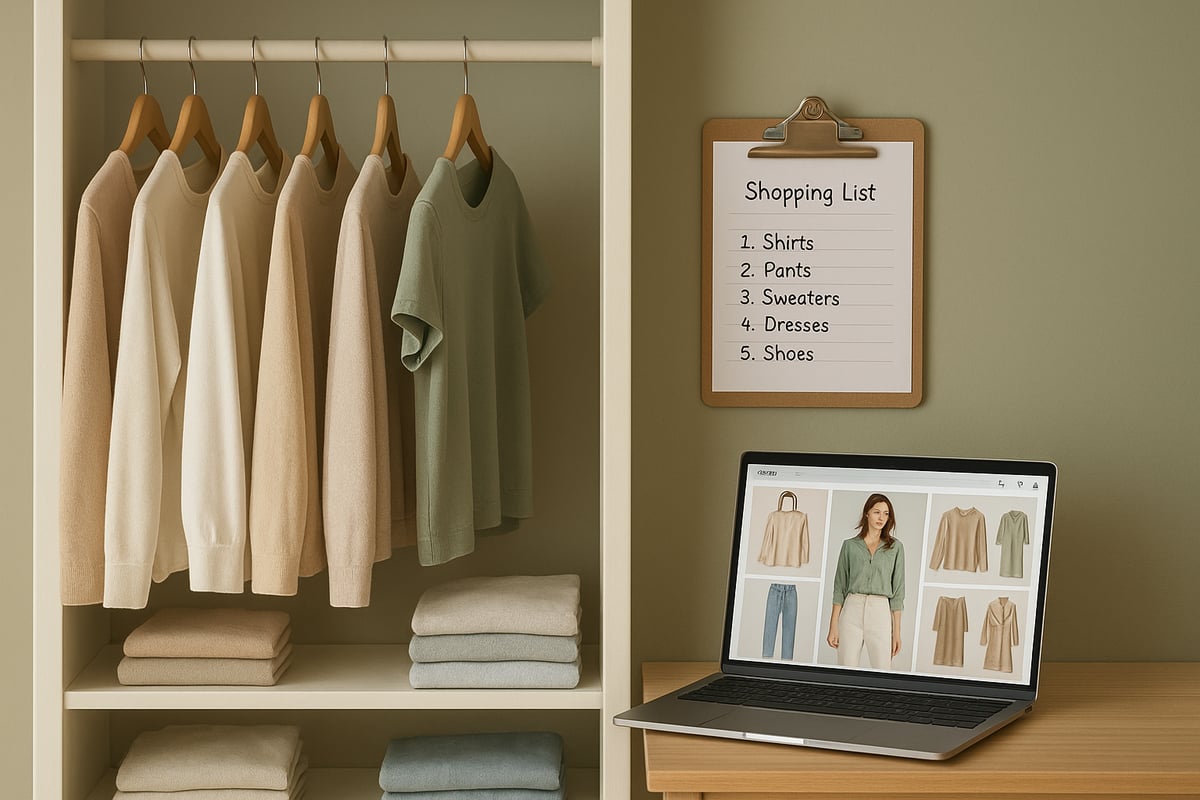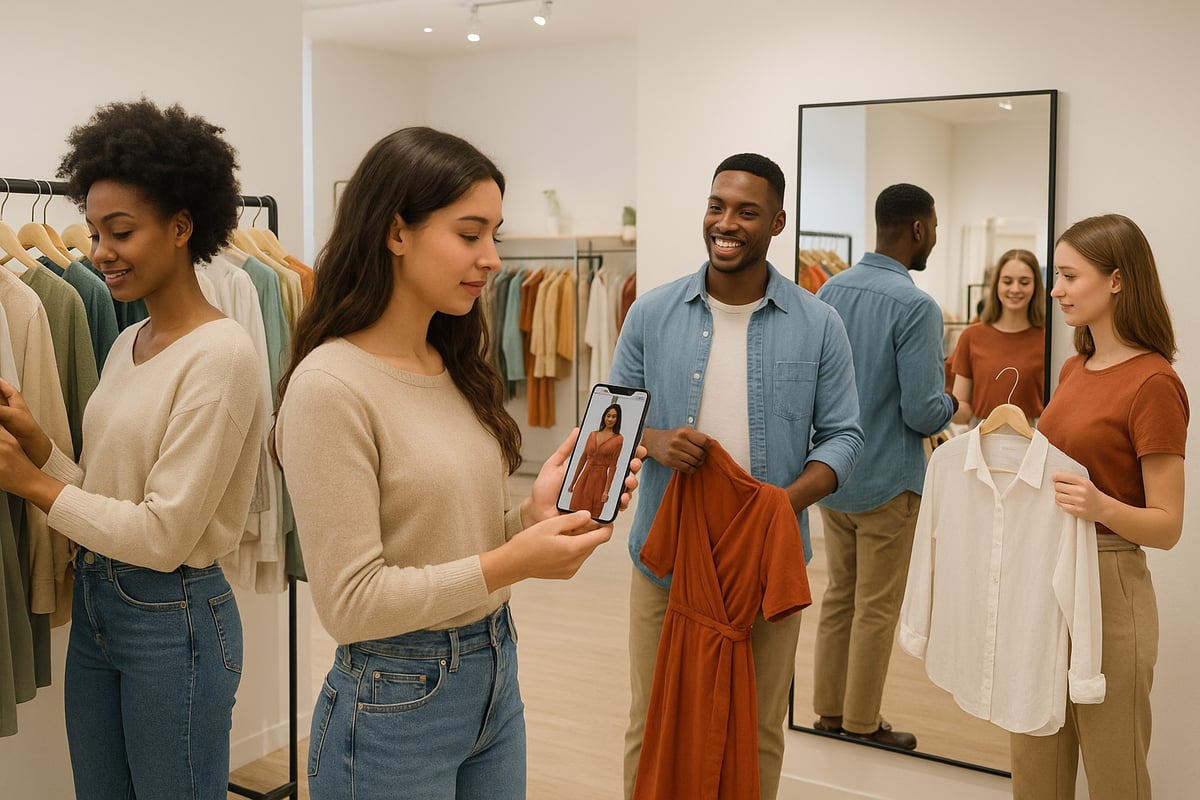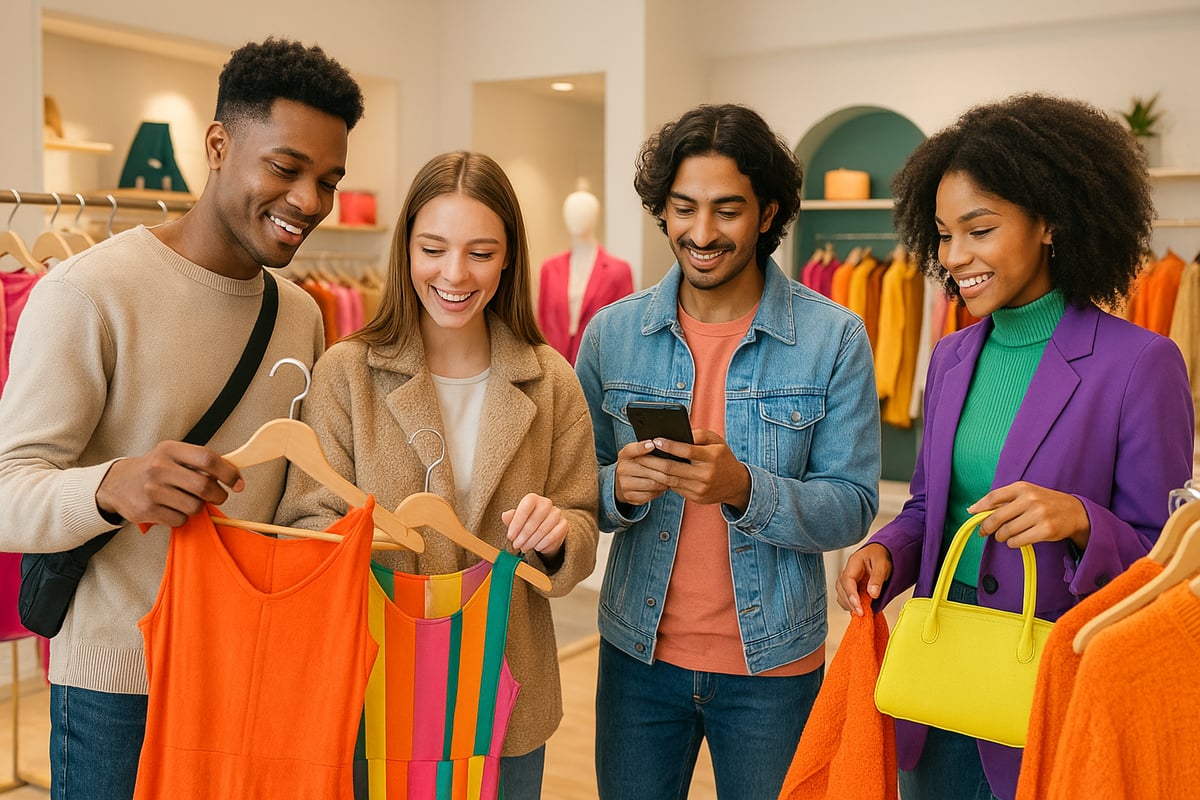Outfit Shopping Guide 2025: Style Tips for Every Beginner
Are you tired of feeling overwhelmed by endless choices every time you go outfit shopping? For many beginners, stepping into the world of fashion can feel intimidating, but learning how to navigate it unlocks countless possibilities for self-expression.
In this guide, you will discover practical ways to shop smarter, dress with confidence, and express your unique personality through style in 2025. We will walk you through actionable tips, step-by-step strategies, and expert insights tailored for first-time shoppers.
Get ready to demystify the process, build your dream wardrobe, and take control of your personal style with ease. Let’s begin your journey to confident, enjoyable outfit shopping.
Understanding Your Personal Style
Cultivating personal style is the foundation of successful outfit shopping. When you understand what you truly like, shopping becomes less overwhelming and more rewarding. Let’s explore how to define, experiment with, and embrace your unique style for a wardrobe that feels authentic and adaptable.

Why Personal Style Matters
Personal style is more than just clothing — it’s a reflection of your identity and confidence. When you shop with a clear sense of style, you avoid impulse buys and build a wardrobe that truly fits your life.
Understanding your preferences streamlines outfit shopping, saving both time and money. Capsule wardrobes, for example, have grown in popularity because they allow for endless combinations with fewer pieces. In fact, 62% of shoppers report higher satisfaction when they buy clothes that match their personal style (Statista, 2023). By prioritizing your style, you make each shopping trip count.
Identifying Your Style Preferences
Start by assessing your lifestyle, daily activities, and what makes you feel comfortable. Look for inspiration on social media, from fashion icons, or even street style snapshots. Create mood boards on Pinterest to collect looks that resonate with you.
Notice patterns in your favorite outfits — do you gravitate toward certain colors, fabrics, or shapes? Exploring curated guides, like the Best Online Boutiques Guide, can help you discover new sources and refine your approach to outfit shopping. Visualizing your style helps you shop with intention.
Exploring Common Style Types
Familiarizing yourself with major style categories can clarify your preferences. Here’s a quick overview:
| Style Type | Key Characteristics | Example Celebrity |
|---|---|---|
| Classic | Timeless cuts, neutral colors | Kate Middleton |
| Casual | Relaxed fits, basics, comfort | Jennifer Aniston |
| Trendy | Latest fashions, bold statements | Zendaya |
| Sporty | Athleisure, sneakers, functional | Serena Williams |
| Minimalist | Simple silhouettes, neutral palette | Steve Jobs |
| Eclectic | Mixed prints, unexpected pairings | Harry Styles |
Recognizing these style types will guide your outfit shopping and help you choose pieces that align with your personality and needs.
Experimenting Without Commitment
If you’re new to outfit shopping, testing styles without a big investment is key. Try renting, borrowing, or thrifting to explore different looks. Many digital platforms now offer virtual try-ons and AR apps, so you can see how outfits suit you before buying.
Start with small changes, like adding new accessories or basics, to update your style gradually. These low-risk strategies let you experiment and gain confidence in your choices.
Embracing Versatility and Authenticity
Building a wardrobe that reflects both current trends and your individuality is the ultimate goal. Prioritize authenticity — it leads to a more sustainable and satisfying approach to outfit shopping.
The rise of “quiet luxury” and understated fashion in 2025 shows that personal style doesn’t have to be loud to be impactful. Choose versatile staples, update with a trendy piece here and there, and always stay true to what feels right for you. As your style evolves, let it reflect your growth rather than fleeting trends.
Preparing for Your Shopping Journey
Starting your outfit shopping journey with the right preparation can make all the difference. A thoughtful approach helps you avoid common pitfalls and ensures every purchase adds value to your wardrobe. Let us explore the essential steps to set yourself up for shopping success.

Setting a Realistic Budget
Budgeting is the foundation of smart outfit shopping. Start by reviewing your finances and deciding how much you can comfortably allocate to clothing. According to Statista, beginners in the US spent an average of $1,100 on wardrobe updates in 2023.
Divide your budget between essentials and statement pieces. Essentials include everyday basics, while statement items are those special pieces that express your style. Try using a simple table to split your funds:
| Category | Suggested % | Example Items |
|---|---|---|
| Basics | 60% | Tees, jeans, shoes |
| Statements | 30% | Jackets, dresses |
| Accessories | 10% | Belts, scarves |
Prioritizing spending in this way helps you get more mileage out of your outfit shopping.
Taking Inventory of Your Closet
Before you buy anything, take stock of what you already own. Outfit shopping is most effective when you know exactly what you need. Begin by removing everything from your closet and sorting items into three groups: keep, donate, or repurpose.
Look for gaps, such as missing basics, or redundancies, like owning five similar shirts. Many find the “one in, one out” rule helpful: for every new purchase, remove an old item. This method ensures your closet stays organized and prevents clutter as you continue outfit shopping.
Researching Brands and Stores
Not all stores are equal, especially for beginners. Investigate which brands align with your values, quality standards, and price range. Consider whether you prefer in-store experiences or online shopping. Many find online boutiques convenient and full of unique finds. For more insights, check out Tips for Online Clothing Boutiques to make the most of digital outfit shopping.
Compare reviews, return policies, and available sizes. Beginner-friendly retailers in 2025 often offer virtual try-ons and generous return periods, making outfit shopping less stressful and more enjoyable.
Creating a Shopping List and Mood Board
A shopping list keeps you focused and curbs impulse buys during outfit shopping. Write down your must-haves, such as a new pair of jeans, and nice-to-haves, like a patterned scarf. Visualize your purchases with a mood board using Pinterest or apps like Closet+ and Stylebook.
This visual approach helps you see how new items fit into your existing wardrobe. It also prevents buying duplicates and keeps your outfit shopping goal-oriented.
Timing Your Shopping for Best Deals
Knowing when to shop can save you money and boost your outfit shopping satisfaction. Take advantage of sales cycles, such as end-of-season clearances, Black Friday, and online flash sales. According to the National Retail Federation, 44 percent of shoppers save more by waiting for sales.
Subscribe to store newsletters and join loyalty programs for early access to discounts. Plan your purchases around upcoming events or seasonal changes to maximize the value of every outfit shopping trip.
Step-by-Step Guide to Smart Outfit Shopping
Embarking on outfit shopping in 2025 can feel complicated, but a systematic approach makes it much easier. By following these steps, you will not only find pieces that reflect your style, but also create a wardrobe that works for your life and budget. Let us break down the process to help you shop smarter and more confidently.

Step 1: Define Your Shopping Goals
Start your outfit shopping journey by clarifying what you truly need. Are you shopping for a specific event, updating your seasonal wardrobe, or filling gaps in your closet? Setting clear goals helps you stay focused and avoid unnecessary purchases.
List your priorities before you shop. Essentials such as versatile tops, comfortable jeans, or a classic blazer should come first. Trendy pieces can be added later for variety. Consider building your wardrobe around a "hero" piece, such as a statement jacket or a favorite pair of shoes. This approach ensures every item you select serves a purpose and complements your overall style.
Step 2: Choose the Right Shopping Channels
With so many options available, choosing where to shop is a big part of successful outfit shopping. Online stores offer convenience, a wide selection, and access to customer reviews. Physical stores provide the advantage of trying items on and seeing fabrics in person.
Virtual fitting rooms and augmented reality apps are making online outfit shopping more accurate and interactive. In 2025, shopping apps and digital marketplaces are especially popular for their curated selections and easy returns. Think about your preferences—do you value speed, variety, or the ability to touch and feel garments? Use a mix of channels for the best experience.
Step 3: Focus on Fit and Comfort
Nothing undermines outfit shopping more than poor fit or discomfort. Sizing can vary widely between brands, so always check size charts and take your own measurements before buying. Try on multiple sizes if possible, and experiment with different silhouettes to discover what feels and looks best.
Many stores now offer inclusive sizing and adaptive clothing options, making it easier for everyone to find flattering pieces. If you need more guidance, check out resources like Trendy Plus Size Stores Shopping for insights on fit and inclusivity. Remember, comfort should always be a priority, as 30% of online returns happen due to poor fit.
Step 4: Assess Quality and Fabric
Quality matters in outfit shopping, especially if you want your clothes to last. Examine the seams, stitching, and fabric composition before purchasing. Durable fabrics such as cotton and wool often outlast cheaper synthetics, while polyester can be lightweight but may not breathe as well.
Look for signs of craftsmanship, like reinforced buttons and neatly finished edges. Compare similar items using a simple table:
| Fabric | Pros | Cons |
|---|---|---|
| Cotton | Breathable, durable | May shrink, wrinkles |
| Polyester | Lightweight, dries fast | Less breathable |
Being attentive to quality ensures your wardrobe is both functional and stylish.
Step 5: Make Thoughtful Decisions
Mindful outfit shopping means avoiding impulse buys and focusing on versatile pieces. Use the "24-hour rule"—wait a day before purchasing to see if you still want the item. Ask yourself if the piece can be styled in at least three different ways. This flexibility maximizes your wardrobe's potential.
Consider the cost-per-wear calculation: divide the price by the estimated number of times you will wear the item. A higher upfront cost may be worthwhile if the piece is truly versatile and durable. This method helps you spend wisely and build a more cohesive closet.
Step 6: Finalize and Care for Your Purchases
Once you complete your outfit shopping, pay attention to garment care. Read labels for washing instructions and follow them to extend the life of your clothes. Basic maintenance, such as gentle washing and proper storage, will keep your purchases looking fresh.
Organize your new items into your existing wardrobe system. Use storage solutions like hanging organizers or wardrobe apps to track and plan outfits. Regularly rotate your clothes to ensure everything gets worn and nothing is forgotten at the back of your closet. With these habits, your outfit shopping efforts will pay off for years to come.
Trend Spotting and Adapting in 2025
Navigating the fast-paced world of outfit shopping in 2025 means staying ahead of evolving trends while remaining true to your personal style. With so many choices and constant changes, knowing how to spot and adapt to new fashion movements is crucial for building a wardrobe that feels both current and authentic.

Top Fashion Trends for 2025
Fashion in 2025 is all about bold expression and conscious choices. Sustainable fabrics, gender-neutral silhouettes, and vivid colors are dominating runways and retail spaces. Digital prints and clothing with integrated technology are also gaining traction, reflecting the blend of innovation and style.
According to fashion executives' expectations for 2025, the industry is set to prioritize eco-friendly materials and digital advancements. For those starting their outfit shopping journey, understanding these trends can help you make purchases that feel fresh and relevant.
- Sustainable materials like organic cotton and recycled polyester
- Tech-integrated pieces, such as smart jackets or app-connected shoes
- Bold hues and digital-inspired patterns
- Gender-neutral cuts and inclusive sizing
How to Incorporate Trends Without Overhauling Your Wardrobe
Adopting new trends does not require replacing your entire closet. Successful outfit shopping means blending trendy items with timeless basics to keep your look updated and versatile.
Start by choosing one or two statement pieces, such as a vibrant printed top or modern accessory. Pair these with classic staples already in your wardrobe. Accessories like bold jewelry or unique shoes can instantly refresh your ensemble without a major investment.
- Mix trendy pieces with neutral basics
- Use accessories to test new looks
- Swap in seasonal items for quick updates
This strategy ensures your outfit shopping stays budget-friendly and sustainable.
Balancing Trends with Timelessness
A smart approach to outfit shopping is to strike a balance between current trends and classic pieces. The "70/30 rule" suggests dedicating 70% of your wardrobe to timeless staples and 30% to trend-driven items.
Consider this table for guidance:
| Classic Staples | Trendy Updates |
|---|---|
| White shirt | Digital print tee |
| Blue jeans | Tech-fabric pants |
| Black dress | Neon accessories |
By investing primarily in enduring essentials, you can experiment with trends each season without feeling overwhelmed. This approach keeps your outfit shopping purposeful and your style consistent.
Staying Informed and Inspired
To keep your outfit shopping fresh, tap into a variety of inspiration sources. Follow fashion influencers, online magazines, and designers who share updates on emerging trends. Social media algorithms, especially on platforms like TikTok, are powerful tools for discovering micro-trends and global styles.
- Subscribe to fashion newsletters
- Save ideas from Pinterest or Instagram
- Participate in style challenges for new ideas
Staying engaged helps you adapt trends creatively to your personal taste.
Avoiding Common Trend Pitfalls
Trends can be tempting, but not every new style will suit your needs or preferences. Avoid the urge to buy every popular item, and instead focus on what aligns with your authentic self. Prioritize comfort and practicality during outfit shopping to ensure you actually wear what you purchase.
- Evaluate if a trend fits your lifestyle
- Test new looks with affordable pieces before committing
- Keep receipts and tags until you are confident in your choices
Being selective means your outfit shopping remains enjoyable and regret-free.
Building a Versatile and Functional Wardrobe
Building a versatile and functional wardrobe is the cornerstone of successful outfit shopping. When you curate your clothing with intention, you maximize your options, save money, and always have something suitable for any event. Let’s break down the steps every beginner should follow to create a wardrobe that is both stylish and practical.
Wardrobe Essentials for Beginners
Every successful outfit shopping journey begins with the right basics. Core pieces like a crisp white shirt, classic denim jeans, a black dress, and neutral shoes form the backbone of your wardrobe. These essentials can be dressed up or down, making them suitable for multiple occasions.
Consider starting with a capsule wardrobe. This approach focuses on a limited number of high-quality items that mix and match seamlessly. For example, a 10-piece starter capsule might include:
- 2 shirts (white and patterned)
- 2 pairs of jeans (light and dark wash)
- 1 black dress
- 1 blazer
- 2 pairs of shoes (casual and formal)
- 1 sweater
- 1 versatile skirt
| Stat | Insight |
|---|---|
| 70% | People wear only 30% of their wardrobe (ClosetMaid, 2023) |
By focusing on essentials, you simplify outfit shopping and reduce decision fatigue.
Mixing and Matching for Maximum Outfits
To get the most from your outfit shopping, learn how to mix and match your pieces. Layering is a powerful tool. Pair a white shirt under a blazer for work, then swap in sneakers for a casual look. Experiment with color coordination and pattern mixing to create fresh combinations.
A single blazer, for example, can be styled five ways: over a dress, with jeans and a tee, layered with a sweater, paired with tailored pants, or even with a skirt. The more adaptable your pieces, the more outfits you can create without extra purchases.
Use outfit shopping as an opportunity to play with accessories, textures, and seasonal layers. Keeping versatility in mind will stretch your wardrobe and budget further.
Shopping for Different Occasions
Outfit shopping should reflect your lifestyle. Think about the events you attend: work, weekends, parties, or travel. Each setting may call for different staples, but many basics can adapt across occasions.
Here’s a quick guide:
| Occasion | Outfit Idea |
|---|---|
| Work | Blazer, tailored pants, loafers |
| Weekend | Jeans, tee, sneakers |
| Party | Black dress, statement earrings |
| Travel | Comfortable pants, layers, crossbody bag |
Seasonal changes also matter. Swap in lighter fabrics and brighter colors for summer, then add sweaters and boots in winter. Outfit shopping with specific occasions in mind helps you avoid unnecessary or redundant purchases.
Accessorizing to Elevate Simple Looks
Accessories are the secret weapon of outfit shopping. Even the simplest ensemble can be transformed with the right jewelry, scarf, or bag. The impact of shoes, bags, and jewelry cannot be underestimated, as a bold accessory instantly makes any outfit feel intentional and fresh.
Consider whether to go for statement pieces or subtle accents. For inspiration, check out Fashionable Accessories for Outfits to see how accessories can add personality and polish.
A bold scarf or hat can turn a basic jeans-and-tee combo into a standout look. Experiment with different accessories to discover what works best for your style.
Organizing and Rotating Your Wardrobe
A well-organized wardrobe is essential for efficient outfit shopping. Use closet organization hacks like shelf dividers, hangers for accessories, and labeled storage boxes for seasonal items. Rotating your wardrobe seasonally keeps only current pieces visible and accessible.
Wardrobe apps such as Closet+ or Stylebook help you track what you own and plan outfits in advance. They also make it easier to identify gaps or redundancies, so your next outfit shopping trip is informed and intentional.
Regular organization ensures you always know what you have, preventing duplicate purchases and making daily outfit selection stress-free.
Sustainable and Ethical Shopping Practices
Sustainability is a major trend in outfit shopping for 2025. Choosing eco-friendly brands, buying secondhand, or participating in clothing swaps reduces your environmental impact. Thrifting and upcycling also offer unique pieces that stand out.
According to Fashion Revolution, 48% of shoppers are seeking sustainable options this year, highlighting a shift in consumer values. For more on this, see Sustainability trends in fashion.
Embracing ethical outfit shopping not only benefits the planet but also leads to a more intentional and meaningful wardrobe.
Overcoming Common Outfit Shopping Challenges
Embarking on your outfit shopping journey can present unique challenges, from sizing confusion to budget limitations. The good news is that these hurdles are common and entirely manageable with the right strategies. Here’s how to navigate the most frequent obstacles for a smoother, smarter shopping experience.
Navigating Sizing and Fit Issues
Sizing inconsistencies across brands can make outfit shopping feel daunting. Begin by measuring yourself with a soft tape measure and recording your bust, waist, hips, and inseam. Refer to each brand’s sizing chart, as sizes often differ between labels.
When shopping online, read reviews that mention fit and fabric stretch. Trying on multiple sizes in-store helps you find the best silhouette for your body. If possible, opt for retailers that offer free returns to reduce the risk of ill-fitting purchases. These steps will help you approach outfit shopping with greater confidence.
Managing Budget Constraints
Budget is a top concern for many beginners. Before you start outfit shopping, determine your spending limit and prioritize essentials over trendy splurges. Allocate funds for basics first, then add statement pieces as your budget allows.
Keep an eye on sales, clearance events, and loyalty programs to maximize value. According to global fashion market value projections, the market’s growth has increased competition, resulting in more frequent promotions and discounts. Consider using apps that alert you to price drops, ensuring you never miss a deal while outfit shopping.
Shopping for All Body Types and Needs
Outfit shopping should be an inclusive experience. Many brands now offer extended sizing and adaptive clothing, catering to a broad spectrum of body types and personal needs. Look for retailers that highlight inclusive sizing charts and customer photos.
When searching for flattering styles, focus on cuts and fabrics that enhance your favorite features. Do not hesitate to seek in-store assistance or use virtual try-on tools for extra guidance. The right fit can help you feel your best in any outfit.
Handling Overwhelm and Decision Fatigue
Outfit shopping can quickly become overwhelming, especially with endless choices and new trends. To manage this, break your shopping into smaller, focused sessions. Make a list of what you need and stick to it, limiting the number of stores or websites you visit in one outing.
Consider bringing a trusted friend for a second opinion or using pre-made checklists to keep your process streamlined. By setting boundaries, you can enjoy outfit shopping without feeling exhausted by too many options.
Avoiding Regret and Returns
Mindful shopping helps prevent buyer’s remorse and unnecessary returns. Always check store return policies before making a purchase, and keep receipts and tags until you are sure about your selections. Try the “24-hour rule”: wait a day before buying to confirm you truly want the item.
If you do need to return something, act promptly to stay within return windows. This approach will help you build a wardrobe you love, with fewer regrets along the way.
Now that you have a clear roadmap for building a stylish and functional wardrobe, why not take the next step toward discovering pieces that truly reflect who you are? At BeauBella's Boutique, you'll find an expertly curated selection of classy, trendy, and affordable fashion for every occasion and budget. Whether you're refining your basics, exploring the latest trends, or searching for those standout accessories, you can confidently put your new shopping strategies into practice. Ready to bring your style vision to life? Shop Now and start building a wardrobe you love.